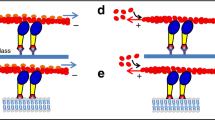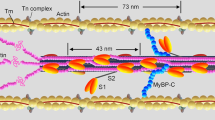Abstract
IT is well established that muscle contraction results from the relative sliding of actin and myosin filaments. Both filaments have definite polarities and well-ordered structures. Thick filaments, however, are not vital for supporting movement in vitro1–4. Pre-viously we have demonstrated that actin filaments can move con-tinuously on myosin fragments (subfragment-1 or heavy meromyosin (HMM)) that are bound to a nitrocellulose surface3. Here we report that actin filaments can move in opposite directions on tracks of myosin heads formed when actin filaments decorated with HMM are placed on a nitrocellulose surface. The actin filaments always move forward, frequently changing the direction of the movement, but never move backward reversing the polarity of the movement. The direction of movement is therefore deter-mined by the polarity of the actin filament. These results indicate that myosin heads have considerable flexibility.
This is a preview of subscription content, access via your institution
Access options
Subscribe to this journal
Receive 51 print issues and online access
$199.00 per year
only $3.90 per issue
Buy this article
- Purchase on Springer Link
- Instant access to full article PDF
Prices may be subject to local taxes which are calculated during checkout
Similar content being viewed by others
References
Yano, M., Yamamoto, Y. & Shimizu, H. Nature 299, 557–559 (1982).
Hynes, T. R., Block, S. M., White, B. T. & Spudich, J. A. Cell 48, 953–963 (1987).
Toyoshima, Y. Y. et al. Nature 328, 536–539 (1987).
Kishino, A. & Yanagida, T. Nature 334, 74–76 (1988).
Huxley, H. E. J. molec. Biol. 7, 281–308 (1963).
Moore, P. B., Huxley, H. E. & DeRosier, D. J. J. molec. Biol. 50, 279–295 (1970).
Yamamoto, K., Pardee, J. D., Reidler, J., Stryer, L. & Spudich, J. A. J. Cell Biol. 95, 711–719 (1982).
Giffard, R. G., Weeds, A. G. & Spudich, J. A. J. Cell Biol. 98, 1796–1803 (1984).
Craig, R. et al. J. molec. Biol. 140, 35–55 (1980).
Winkelmann, D. A. & Lowey, S. J. molec. Biol. 188, 595–612 (1986).
Miyanishi, T., Toyoshima, C., Wakabayashi, T. & Matsuda, G. et al. J. Biochem., Tokyo 103, 458–462 (1988).
Kinosita, K., Ishiwata, S., Yoshimura, H., Asai, H. & Ikegami, A. Biochemistry 23, 5963–5975 (1984).
Reedy, M. C., Beall, C. & Fyrberg, E. Nature 339, 481–483 (1989).
Kron, S. J. & Spudich, J. A. Proc. natn. Acad. Sci. U.S.A. 83, 6272–6276 (1986).
Author information
Authors and Affiliations
Rights and permissions
About this article
Cite this article
Yano Toyoshima, Y., Toyoshima, C. & Spudich, J. Bidirectional movement of actin filaments along tracks of myosin heads. Nature 341, 154–156 (1989). https://doi.org/10.1038/341154a0
Received:
Accepted:
Issue Date:
DOI: https://doi.org/10.1038/341154a0
This article is cited by
-
A myosin II nanomachine mimicking the striated muscle
Nature Communications (2018)
-
Translational actomyosin research: fundamental insights and applications hand in hand
Journal of Muscle Research and Cell Motility (2012)
-
Ultra-fastChara myosin: A test case for the swinging lever arm model for force production by myosin
Journal of Plant Research (1996)
-
Modification of the bi-directional sliding movement of actin filaments along native thick filaments isolated from a clam
Journal of Muscle Research and Cell Motility (1996)
-
Interaction of pollen F-actin with rabbit muscle myosin and its subfragments (HMM, S1)
Protoplasma (1995)
Comments
By submitting a comment you agree to abide by our Terms and Community Guidelines. If you find something abusive or that does not comply with our terms or guidelines please flag it as inappropriate.



